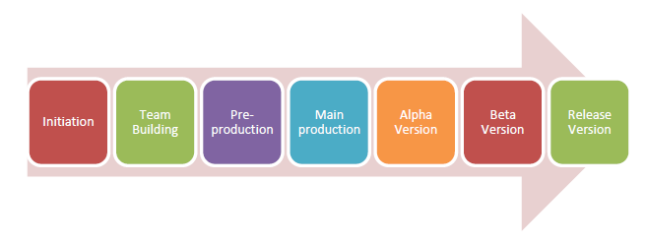Okay, here at last, I present you the continuation of my research: Game Development Lifecycle (GDLC).
What is GDLC? In brief explanation, it’s an approach how to handle a game development project. Why do you need GDLC? It’s not that you’ll really need it, but it’ll guide you through needed steps to develop a game and minimize the risk.
Refering to my old post, if you want to be a developer, you can start now. How to do that? Start reading now.
To the main question: What steps need to be taken? In this post, I’ll present you my hypothesis of what GDLC phases should be taken.
- Initiation
- Team building
- Pre-production
- Production
- Alpha version
- Beta version
- Release version
1. Initiation
It’s all where it begins. Initiation is the part where you decide what kind of game you’ll make, who’s the hero, how to play the game, etc. It’s the very basic of game design/game concepting.
To-do list:
- Define the game
- Look for publisher
Useful pointer: Answer these question first!
- Brainstorming!
- What kind of game you’ll make?
- Who’s the hero/protagonist?
- Will it be 2D or 3D game?
- What’s the theme?
- What features it’ll be?
- Who’s your potential player/user? What gender, how old are they?
2. Team Building
Team building is essentially the same as staffing. At first, the team you have maybe consists of 3 to 10 people. However, you know that you need some extra muscles to do the job, and ensure that the whole team have the same vision as you are (assuming you’re the project leader).
To-do list:
- Staffing/hiring
- Create team structure
- Delegating jobs to members
- Goal/vision synchronization
3. Pre-production
One of the most important thing before jump directly to code the game: Pre-production. It’s the same as planning and designing the game itself.
To-do list:
- Brainstorming! (again)
- Design the gameplay (core gameplay, mini games, etc)
- Define the art, style, and assets
- Choose the game engine and target platform
- Build prototype/mock-up/early design
- Create documentation: Art Design Document, Technical Design Document, Game Design Document
- Schedule planning
4. Production
It’s time to pour everything you’ve design to become a game. The longest and exhaustive phase of the game development, production deals with the game codes and assets themselves.
To-do list:
- Coding (use framework/game engine to make it easier)
- Create assets (graphical and sound)
- Integrate source code and assets
- Giving milestone for each deliverable
- Evaluate
- Meeting
5. Alpha Version
Alpha version is the phase where the game itself is playable, but incomplete. For example, if the game has some playable level, it has already reach alpha version. Most of the core gameplay must be already included in the alpha version game.
To-do list:
- Alpha testing (testing by fellow developer/another team member)
- Bug fixing
- Continue production
Important note:
- Alpha version game means the whole gameplay concept is already fixed. No gameplay concept may change after a game is declared alpha, otherwise it’s not alpha.
- Alpha testing is used to check usability error
6. Beta Version
Beta version is the phase where all the game is all set. It means, beta version game is already a full game.
To-do list:
- Beta testing (testing by 3rd party)
- Collecting user feedback
- Bug fixing
- Balancing
Important note:
- Beta testing is used to expose bug, glitch, and exploits which encountered during the gameplay.
- Beta testing may be divided into 2 phase: open beta, where all the tester can freely join to participate, or closed beta, where all the tester are selected via test/invitation.
7. Release Version
It’s when all of the efforts rewarded. Release version means the game is ready to launch and to be shipped. Usually a game launching being held in somekind of party, but it’s entirely optional.
To-do list:
- Game launching
- Maintenance!
Useful pointer:
- Don’t stop the developement of the game when it’s already launched. Software patching, expanding the game via update, and maintenance become important thing in game development.
- Don’t lose connection with your publisher. If this project successful, they’re most likely willing to fund your new project.

Really awesome
Keep it up
saya masih kebingungan dikarenakan tidak dijelaskannya tahapan seperti Brainstorming itu apa, boleh saya meminta jurnal anda berupa .pdf agar saya bisa lebih memahami. akan saya gunakan sebagai literatur di tugas akhir saya.